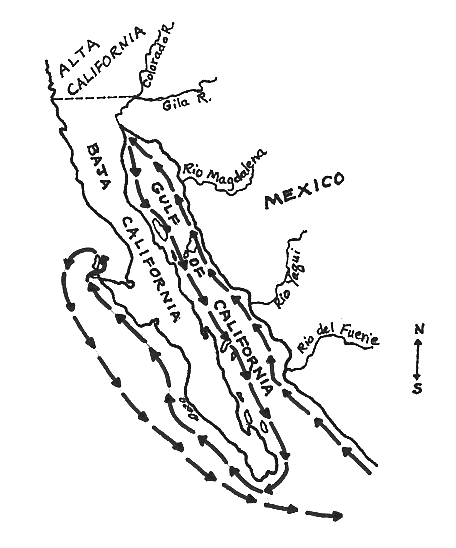| ||||
|
| ||||
|
FRANCISCO
DE ULLOA
and the Naming of California
 Lived:
in the 1500s
Lived:
in the 1500s
Explored California in: 1539-40
Exploring for: Spain
Explored: by ship in the Gulf of California
To Francisco de Ulloa, a Spanish soldier, goes credit for discovering that Baja (Lower) California is a peninsula, not an island. Also, it was after Ulloa’s voyage that the name of “California” came into use.
EARLY HISTORY
We would likely not know about Francisco de Ulloa were it not for his connection with the Spanish conqueror, Hernándo Cortés. Ulloa was under the command of Cortés in New Spain (Mexico). Some sources say that Ulloa was related to Cortés. Whether it was because he was a kinsman or because Ulloa was a trusted soldier, Cortés chose him to make an important expedition.
BACKGROUND
Cortés Searches for Gold
In 1521 Hernándo Cortés conquered the Aztecs in central Mexico. With this part of the land firmly in Spain’s control, Cortés explored both to the south and the north. By 1535 he had pushed northwestward, driven by tales of gold and great wealth said to exist in the legendary Seven Cities of Cibola. Since Cortés had found much gold in the Aztec capital of Tenochtitlan, he saw no reason not to believe the stories about Cibola.
“California”
Along with the stories about Cibola, Cortés had heard of an island called “California” which was a paradise ruled by a queen named Califía. About 1510 a Spanish writer named García Ordóñez de Montalvo had written a novel called Las Sergas de Esplanadían, or The Exploits of Esplanadían.
Montalvo wrote: “On the right hand of the Indies there is an island called California, near paradise on earth, inhabited by black women who have no men living among them, who live like Amazons … Their weapons are all made of gold … There are many griffins in California ... when they are little, the women catch them and bring them up. They feed them with the men whom they take prisoners, and with boys who are born there.”
The First Search for “California”
In 1524 Cortés had written to the King of Spain telling him that this rich island might well be off the coast of northwest Mexico. In 1533 Cortés sent an expedition that crossed the Gulf of California from Mexico and reached what is now known as Baja California, which they thought to be a large island. This expedition was led by Fortún Jiménez. Rather than a paradise ruled by women, however, Jiménez found a hot, desert land and Indians who were not pleased to see Spanish soldiers.
Though this did not appear to be a place of gold and wealth, Cortés decided to establish a colony here. In 1535 he led an expedition of 300 men and 37 women to settle in Baja California. They called it the Isle of Pearls. The settlement did not last long. The land was too dry for farming, they found no precious metals, and the colony soon disbanded.
ULLOA’S JOURNEY
In 1539, Cortés sent Francisco de Ulloa to explore the Gulf of California, which is also known as the Sea of Cortez. At this time, everyone thought that this body of water was part of the Pacific Ocean, and that the land visited by Jiménez a few years earlier was an island. Ulloa sailed from Acapulco, on the west coast of Mexico, with three ships. The smallest of these was soon lost in a storm.
Ulloa’s other two ships (the Santa Agueda and the Trinidad) made their way northward along the coast of Mexico, passing the tip of Baja California and entering the narrow Gulf. This body of water is about 700 miles long but not more than 100 miles across at its widest point.
When Ulloa had covered most of the 700 miles, he found his way blocked by sandbars covered by shallow water. There was a strong current here, which Ulloa believed to be caused by a river flowing into the Gulf. He was convinced that his ships could go no further, so he turned and started down the other side of the Gulf.
Ulloa sailed down the 700 miles of the Gulf along the Baja California side, and rounded Cabo San Lucas, the tip of Baja California. He then sailed several hundred miles up the Pacific Coast side of the peninsula.
The weather was now stormy, as it was winter, and the ships had trouble making progress. They had been damaged by the storms, and many of the crew were ill from scurvy. At last Ulloa turned around and headed back towards Acapulco. He had traveled about 2,000 miles.
WHAT HE ACCOMPLISHED
Ulloa had proved that Baja California was not an island, as previously thought, but a peninsula. He had traveled along the coast to within about 130 miles of the present-day California-Mexico border.
Ulloa had described the strong current at the head of the Gulf as “water white, like river water.” He did not get close enough to see that this was the mouth of the great Colorado River.
Soon after Ulloa’s voyage, the people in New Spain began calling the peninsula by the name of California.
LATER YEARS
Ulloa slipped from history as silently as he came onto the scene. One report says that he was murdered by one of his sailors soon after reaching port on the west coast of Mexico.